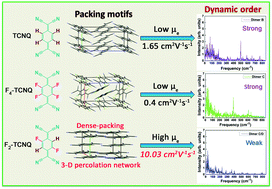当前位置:
X-MOL 学术
›
Phys. Chem. Chem. Phys.
›
论文详情
Our official English website, www.x-mol.net, welcomes your
feedback! (Note: you will need to create a separate account there.)
Theoretical study on the charge transport in single crystals of TCNQ, F2-TCNQ and F4-TCNQ†
Physical Chemistry Chemical Physics ( IF 2.9 ) Pub Date : 2018-01-02 00:00:00 , DOI: 10.1039/c7cp07189b Li-Fei Ji 1, 2, 3, 4, 5 , Jian-Xun Fan 1, 2, 3, 4, 5 , Shou-Feng Zhang 1, 2, 3, 4, 5 , Ai-Min Ren 1, 2, 3, 4, 5
Physical Chemistry Chemical Physics ( IF 2.9 ) Pub Date : 2018-01-02 00:00:00 , DOI: 10.1039/c7cp07189b Li-Fei Ji 1, 2, 3, 4, 5 , Jian-Xun Fan 1, 2, 3, 4, 5 , Shou-Feng Zhang 1, 2, 3, 4, 5 , Ai-Min Ren 1, 2, 3, 4, 5
Affiliation

|
2,5-Difluoro-7,7,8,8-tetracyanoquinodimethane (F2-TCNQ) was recently reported to display excellent electron transport properties in single crystal field-effect transistors (FETs). Its carrier mobility can reach 25 cm2 V−1 s−1 in devices. However, its counterparts TCNQ and F4-TCNQ (tetrafluoro-7,7,8,8-tetracyanoquinodimethane) do not exhibit the same highly efficient behavior. To better understand this significant difference in charge carrier mobility, a multiscale approach combining semiclassical Marcus hopping theory, a quantum nuclear enabled hopping model and molecular dynamics simulations was performed to assess the electron mobilities of the Fn-TCNQ (n = 0, 2, 4) systems in this work. The results indicated that the outstanding electron transport behavior of F2-TCNQ arises from its effective 3D charge carrier percolation network due to its special packing motif and the nuclear tunneling effect. Moreover, the poor transport properties of TCNQ and F4-TCNQ stem from their invalid packing and strong thermal disorder. It was found that Marcus theory underestimated the mobilities for all the systems, while the quantum model with the nuclear tunneling effect provided reasonable results compared to experiments. Moreover, the band-like transport behavior of F2-TCNQ was well described by the quantum nuclear enabled hopping model. In addition, quantum theory of atoms in molecules (QTAIM) analysis and symmetry-adapted perturbation theory (SAPT) were used to characterize the intermolecular interactions in TCNQ, F2-TCNQ and F4-TCNQ crystals. A primary understanding of various noncovalent interaction responses for crystal formation is crucial to understand the structure–property relationships in organic molecular materials.
中文翻译:

TCNQ,F 2 -TCNQ和F 4 -TCNQ单晶中电荷传输的理论研究†
最近报道了2,5-二氟-7,7,8,8-四氰基喹二甲烷(F 2 -TCNQ)在单晶场效应晶体管(FET)中显示出出色的电子传输性能。在设备中,其载流子迁移率可以达到25 cm 2 V -1 s -1。然而,其对应物TCNQ和F 4 -TCNQ(四氟-7,7,8,8-四氰基喹二甲烷)没有表现出相同的高效行为。为了更好地理解电荷载流子迁移率的这一显着差异,采用了多尺度方法,结合了半经典的Marcus跳变理论,量子核使能的跳变模型和分子动力学模拟,以评估F n -TCNQ(n= 0、2、4)系统中的这项工作。结果表明,F 2 -TCNQ的出色电子传输行为归因于其有效的3D电荷载流子渗滤网络,这归因于其特殊的堆积图案和核隧穿效应。此外,TCNQ和F 4 -TCNQ的运输性能差是由于它们的无效包装和强烈的热失调。发现马库斯理论低估了所有系统的迁移率,而具有核隧穿效应的量子模型与实验相比提供了合理的结果。此外,F 2的带状传输行为量子核使能的跳跃模型很好地描述了-TCNQ。此外,分子中的原子量子理论(QTAIM)分析和对称适应的微扰理论(SAPT)用于表征TCNQ,F 2 -TCNQ和F 4 -TCNQ晶体之间的分子间相互作用。对晶体形成的各种非共价相互作用的初步了解对于理解有机分子材料中的结构-性质关系至关重要。
更新日期:2018-01-02
中文翻译:

TCNQ,F 2 -TCNQ和F 4 -TCNQ单晶中电荷传输的理论研究†
最近报道了2,5-二氟-7,7,8,8-四氰基喹二甲烷(F 2 -TCNQ)在单晶场效应晶体管(FET)中显示出出色的电子传输性能。在设备中,其载流子迁移率可以达到25 cm 2 V -1 s -1。然而,其对应物TCNQ和F 4 -TCNQ(四氟-7,7,8,8-四氰基喹二甲烷)没有表现出相同的高效行为。为了更好地理解电荷载流子迁移率的这一显着差异,采用了多尺度方法,结合了半经典的Marcus跳变理论,量子核使能的跳变模型和分子动力学模拟,以评估F n -TCNQ(n= 0、2、4)系统中的这项工作。结果表明,F 2 -TCNQ的出色电子传输行为归因于其有效的3D电荷载流子渗滤网络,这归因于其特殊的堆积图案和核隧穿效应。此外,TCNQ和F 4 -TCNQ的运输性能差是由于它们的无效包装和强烈的热失调。发现马库斯理论低估了所有系统的迁移率,而具有核隧穿效应的量子模型与实验相比提供了合理的结果。此外,F 2的带状传输行为量子核使能的跳跃模型很好地描述了-TCNQ。此外,分子中的原子量子理论(QTAIM)分析和对称适应的微扰理论(SAPT)用于表征TCNQ,F 2 -TCNQ和F 4 -TCNQ晶体之间的分子间相互作用。对晶体形成的各种非共价相互作用的初步了解对于理解有机分子材料中的结构-性质关系至关重要。











































 京公网安备 11010802027423号
京公网安备 11010802027423号